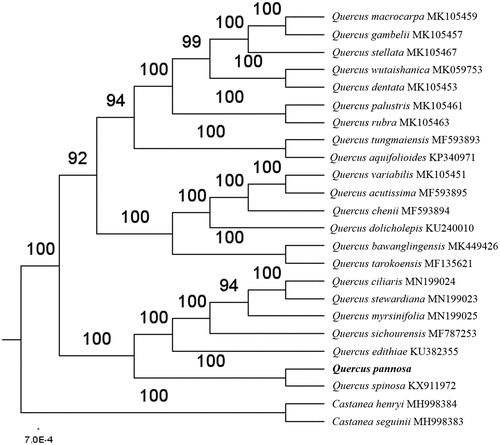Abstract
The first complete chloroplast genome (cpDNA) sequence of Quercus pannosa was determined from Illumina HiSeq pair-end sequencing data in this study. The cpDNA is 161,222 bp in length, contains a large single-copy region (LSC) of 90,522 bp and a small single-copy region (SSC) of 19,000 bp, which were separated by a pair of inverted repeats (IR) regions of 25,850 bp. The genome contains 130 genes, including 85 protein-coding genes, 8 ribosomal RNA genes, and 37 transfer RNA genes. Further phylogenomic analysis showed that Q. pannosa and Q. edithiae clustered in a unique clade in Quercus genus.
Quercus pannosa is the species of the genus Quercus belonging to the family Fagaceae, native to Sichuan, Guizhou, Yunnan of China (Zhang et al. Citation2007). It is an evergreen sclerophyllous oak, and is an important component of montane forests at altitudes between 2500 and 4300 m in the Hengduan Mountains (Zhang et al. Citation2005). It has strong clonal initiation ability and affects its population regeneration and pattern characteristics (Yang et al. Citation2019). The plants of Quercus have the functions of clearing away heat and detoxification, astringent hemostasis (Ou et al. Citation2013). However, there has been no genomic studies on Q. pannosa.
Herein, we reported and characterized the complete Q. pannosa plastid genome. The GenBank accession number is MT180076. One Q. pannosa individual (specimen number: 201910023) was collected from Shangri-La, Yunnan Province of China (27°11′29″N, 96°47′21″E). The specimen is stored at the herbaria, YAF and YCP and the accession number is MJZ0018. DNA was extracted from its fresh leaves using DNA Plantzol Reagent (Invitrogen, Carlsbad, CA, USA).
Paired-end reads were sequenced by using Illumina HiSeq system (Illumina, San Diego, CA). In total, about 19.7 million high-quality clean reads were generated with adaptors trimmed. Aligning, assembly, and annotation were conducted by CLC de novo assembler (CLC Bio, Aarhus, Denmark), BLAST, GeSeq (Tillich et al. Citation2017), and GENEIOUS v 11.0.5 (Biomatters Ltd, Auckland, New Zealand). To confirm the phylogenetic position of Q. pannosa, other 21 species of Quercus genus from NCBI were aligned using MAFFT v.7 (Katoh and Standley Citation2013). The auto algorithm in the MAFFT alignment software was used to align the 24 complete genome sequences and the G-INS-i algorithm was used to align the partial complex sequences. The maximum likelihood (ML) bootstrap analysis was conducted using RAxML (Stamatakis Citation2006); bootstrap probability values were calculated from 1000 replicates. Castanea henryi (MH998384) and Castanea seguinii (MH998383) were served as the outgroup.
The complete Q. pannosa plastid genome is a circular DNA molecule with the length of 161,222 bp, contains a large single-copy region (LSC) of 90,522 bp and a small single-copy region (SSC) of 19,000 bp, which were separated by a pair of inverted repeats (IR) regions of 25,850 bp. The overall GC content of the whole genome is 36.9%, and the corresponding values of the LSC, SSC, and IR regions are 34.7%, 31.0%, and 42.7%, respectively. The plastid genome contained 130 genes, including 85 protein-coding genes, 8 ribosomal RNA genes, and 37 transfer RNA genes. Phylogenetic analysis showed that Q. pannosa and Q. edithiae clustered in a unique clade in Quercus genus (). The determination of the complete plastid genome sequences provided new molecular data to illuminate the Quercus genus evolution.
Disclosure statement
No potential conflict of interest was reported by the author(s).
Additional information
Funding
References
- Katoh K, Standley DM. 2013. MAFFT multiple sequence alignment software version 7: improvements in performance and usability. Mol Biol E. 30(4):772–780.
- Ou YB, Wei MJ, Li HR. 2013. Chemical constituents of Quercus pannosa. Chin Tradit Herbal Drugs. 44(14):1872–1876.
- Stamatakis A. 2006. RAxML-VI-HPC: maximum likelihood-based phylogenetic analyses with thousands of taxa and mixed models. Bioinformatics. 22(21):2688–2690.
- Tillich M, Lehwark P, Pellizzer T, Ulbricht-Jones ES, Fischer A, Bock R, Greiner S. 2017. GeSeq – versatile and accurate annotation of organelle genomes. Nucleic Acids Res. 45(W1):W6–W11.
- Yang J, Zhong QJ, Wang CY, He MC, Zhang TB, Wu TK, Peng MC. 2019. Spatial pattern analysis of Quercus pannosa population at different altitudes in Yunnan Yaoshan. Ecol Sci. 38(5):111–118.
- Zhang SB, Zhou ZK, Hu H, Xu K. 2007. Gas exchange and resource utilization in two alpine oaks at different altitudes in the Hengduan Mountains. Can J for Res. 37(7):1184–1193.
- Zhang SB, Zhou ZK, Hu H, Xu K, Yan N, Li SY. 2005. Photosynthetic performances of Quercus pannosa vary with altitude in the Hengduan Mountains, southwest China. For Ecol Manag. 212(1–3):291–301.

